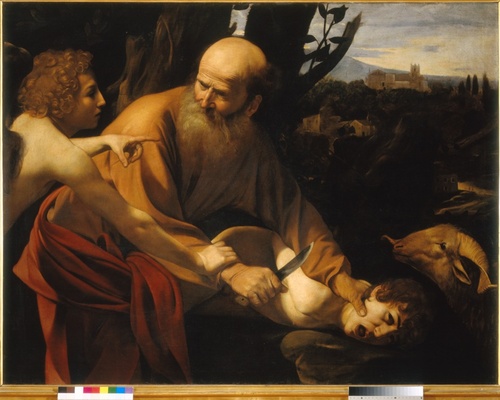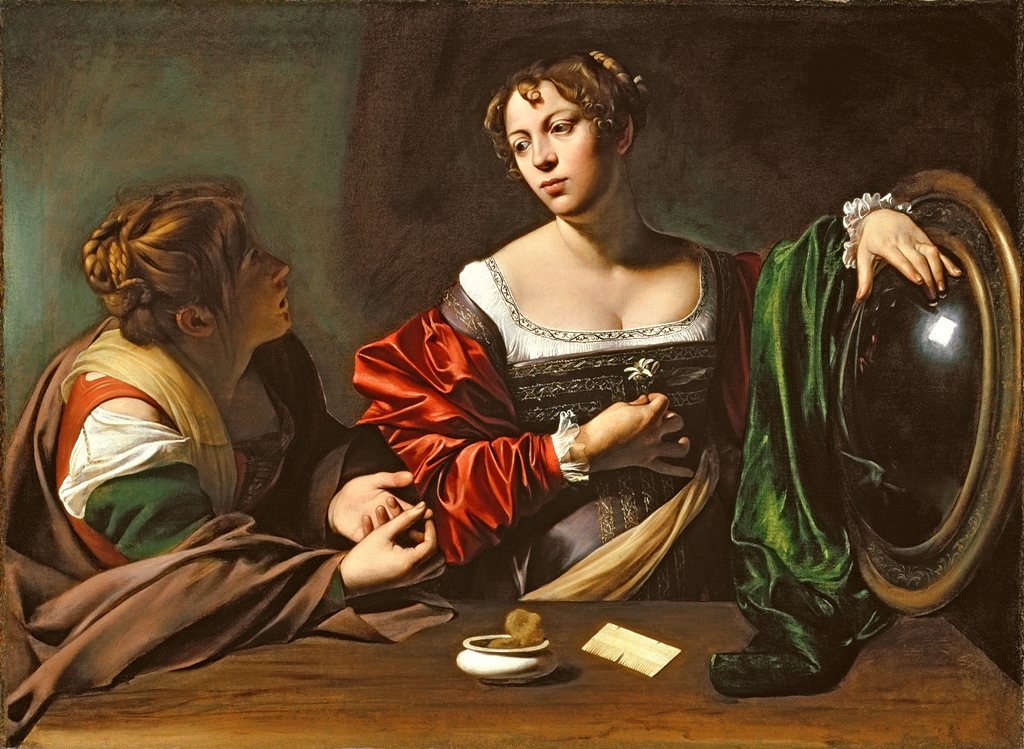
Offending the Clergy: Caravaggio at the National Gallery
Works by the Italian painter cast a long shadow during their first trip to Canada.
Caravaggio's "The Sacrifice of Isaac," c. 1603, from the collection of the Uffizi Gallery, Florence.
Michelangelo Merisi da Caravaggio (1571-1610), a painter who broke with tradition and helped usher in the Baroque period in painting, has finally made the trip to Canada: the exhibit Caravaggio and his Followers in Rome is currently on display at the National Gallery in Ottawa. The event is beyond rare. Works by Caravaggio—whom some call the first modern painter—have never before been shown in this country. For anyone interested in the intense, challenging paintings by Caravaggio, and others from his milieu, the exhibit is welcome news.
There are only twelve of Caravaggio's paintings in the exhibit. The remaining pieces are by contemporaries who were influenced by his work. Obtaining even those twelve Caravaggio pieces was a considerable feat, as only two Caravaggio paintings reside in the United States, and none in Canada. (The Gallery estimates that only about seventy of his paintings have survived at all.) Some of his best-known works are altarpieces and therefore unlikely to ever make it to North America. The endurance of those religious paintings is, in a way, surprising; Caravaggio is known for his original approach to biblical themes—one which often shocked and offended his patrons.
The convention in religious painting at the end of the sixteenth century was to create idealized religious scenes, to make preliminary drawings for perfectly planned compositions. Caravaggio made no such preparations. He painted using live models from the streets of Italy, rendering them as real people with flesh, blood, and bone, and raw human emotions. He is famously believed to have used the corpse of a drowned prostitute for a painting of the death of the Virgin Mary—a choice which caused the parish who had commissioned the work to reject it outright. (One contemporary even complained that Caravaggio's pictures were "forensic.") Caravaggio also portrayed himself in some paintings, including "David with the Head of Goliath"; he himself was the model for the grimacing severed head.
Caravaggio's tumultuous life is legendary, and his violent and defiant reputation certainly hasn't detracted from his current popularity. Much of what is known of his life comes from court records that track his various crimes, including numerous assaults and even a murder (by sword; possibly over a tennis match). Another main source for information is a biography written not long after his death by his enemy and archrival Giovanni Baglione—a man whose own painting style was heavily indebted to Caravaggio. (Baglione took full advantage of the opportunity to have the last word; "he died as miserably as he lived," he wrote of Caravaggio. A Baglione painting is featured in the National Gallery's exhibit.)

Caravaggio's "The Conversion of the Magdalene," c. 1598, from the collection of the Detroit Institute of Art.
Caravaggio's style and subject matter varied considerably over his short career. He painted some portraits; secular scenes of everyday life, featuring lovely, full-lipped young men with musical instruments or overripe fruit, sometimes in scenes drawn from classical myth; and biblical scenes, many of which are his best-known images. These are the paintings in which Caravaggio's radical, dramatic use of chiaroscuro—the treatment of light and shade—is most dramatic and memorable. Often, only a few portions of the figures are touched by a beam of light. The darkness in the background is as thick as felt curtain. The furrows on an agonized brow look like crevices; in "The Sacrifice of Isaac," there is potent heaviness to the bent wrist of a knife-wielding father, ready to slit the throat of his terrified son.
Caravaggio's work made him no shortage of enemies. He was accused of destroying art and even called the "Antichrist" of painting. He was more or less neglected after his death, and remained so until the early twentieth century. During his lifetime, however, Caravaggio's radical style was widely admired and imitated. Caravaggio and his Followers in Rome explores the effect he had on painting by surrounding his works with paintings that bear clear signs of Caravaggio's influence. The exhibit's assistant curator, Christopher Etheridge, says the arrangement lets viewers see how Caravaggio opened up new possibilities in painting. Some of these paintings are direct exercises in imitation, but most of the works included take key strategies from Caravaggio and develop them in new directions, with varying degrees of success. Some of the paintings here are good, some excellent, and some strange.
It doesn't require a vast knowledge of art to appreciate many of the paintings at Caravaggio and his Followers in Rome—especially when an entire room is devoted mainly to depictions of gory beheadings. But, to be safe, the National Gallery has also provided an activity room for children. One of the activities involves an empty gilded frame: visitors can dress up in Baroque costumes and pose for Caravaggio-esque pictures behind it.
I asked the gallery attendant whether anyone had dared to strike the poses from The Sacrifice of Isaac, in which Abraham, on the verge of murdering his son, is restrained at the last moment by an angel. Yes, she told me, still smiling—but did I detect a flicker of unease?—a father and son had had themselves photographed in those famous poses the day before.
Caravaggio and his Followers in Rome is on display at the National Gallery of Canada (380 Sussex Drive, Ottawa) until September 11.
(All images courtesy of the National Gallery.)
Related on maisonneuve.org:
—Negotiating Negative Peace: The Good Cause at the CCA
—The Choreographic Almagamation Phenomenon
—Rouge Cabaret: The Terrifying and Beautiful World of Otto Dix
Subscribe — Follow Maisy on Twitter — Like Maisy on Facebook





